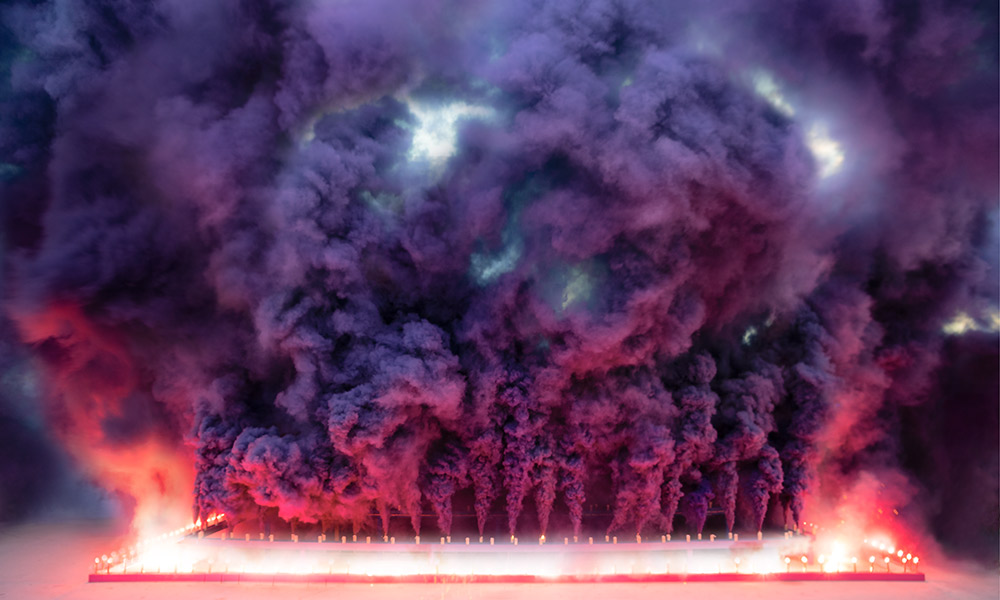For famed artist Judy Chicago, colour resonates throughout her oeuvre in a deeply psychological way, extending beyond its ability to excite on a purely visual level. “Colour is the through line in my work, whether ephemeral or explored in more tangible forms such as paintings or sculpture. Colour is a doorway to many aspects of the human condition—from the terrifying to the sublime.” Chromatic play is especially evident in her Smoke Sculptures™, as she calls them, which are large-scale, site-specific installations composed of non-toxic multicoloured smoke and other pyrotechnics. Right now, she’s preparing for A Tribute to Toronto, a smoke sculpture that will debut at Sugar Beach overlooking Lake Ontario as part of the Toronto Biennial of Art this June.
Though best known for her multimedia installation, The Dinner Party (1974–1979), which featured 39 place settings honouring different women from history and mythology, the Chicago-born artist has been working with pyrotechnics for decades. She began using smoke, fireworks, and dry ice in the 1960s
as part of an effort to “soften that macho land art scene.” Using colourful vapours to express emotions and transience, works like Atmospheres (1968)—a series of performances in California—were intentionally ephemeral and did not permanently alter the natural environment. This approach stood in contrast to the severe minimalism favoured by the male-dominated land art milieu of the ’60s and ’70s. During these decades, Chicago’s work (including performance and installation, paintings, textiles, ceramics, and various groundbreaking feminist pedagogical projects) was often overlooked or devalued for its perceived populist qualities.

Purple Poem for Miami, 2019. Fireworks performance Commissioned by the Institute of Contemporary Art, Miami.
Ironically, many of the traits that critics initially derided—Chicago’s penchant for bright colours, as well as her interest in domestic crafts and a so-called feminine perspective—would become the very cornerstones of her later success. Over the past 50 years, her rich commingling of nuanced social critique, in-depth research, and vivid multimedia presentation have cemented Chicago’s status as a pre-eminent 20th- and 21st-century artist. In 2021, she had a retrospective at the de Young Museum in San Francisco that received rave reviews, and in the same year she published The Flowering, an autobiography lauded by both Gloria Steinem and Roxane Gay. On experiencing such a glowing reception in her 80s, Chicago says, “It’s a miracle. I guess it demonstrates that, if you live long enough, you never know what will happen.”
Though Chicago’s focus and primary medium have evolved over her six-decade career, she’s often returned to working with coloured smoke, intrigued by its potential to temporarily augment a given environment. For A Tribute to Toronto, the artist has been collaborating closely with Chris Souza, of Pyro Spectaculars, whom she calls her “pyrotechnics partner.” Chicago reveals that she initially “called the Smoke Sculptures™ ‘Atmospheres’ to indicate that I was trying to transform the atmosphere, which was exceedingly inhospitable to women.” In the ’60s, her critique was mostly centred on the hypermasculine, clubby art scene.
Today, the environmental connotations of her work ring out even louder. “People are always asking me whether things have ‘gotten better’ for women artists or whether the ‘scene’ has indeed softened. Sadly, I would say that things have gotten worse, not only in the art world but in general. We are on the brink of global chaos brought on by the climate crisis, a lack of political leadership, and rampant greed.” Seen in this light, the mutable nature of Chicago’s sculptures reflects not only the beauty of natural spaces but also their—and our—vulnerability.

